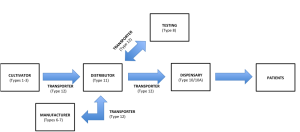The cannabis supply chain under the MMRSA is a mystery to many. Read on to unlock it and understand the “checks and balances” that could improve consumer safety and business efficiency.
From the patient’s perspective, nothing really changes under the MMRSA – patients will continue to get their weed from dispensaries the same way as they do today. From the logistics side of things, however, it’s a whole new ballgame. Long gone will be the days where weed is grown in backyards, basements or warehouses and then sold by vendors to dispensaries with little to no paper trail. Now, with the MMRSA, there are new players in the game: licensed distributors and transporters. Under the new system, cultivators and manufacturers must send all products to a licensed third-party distributor who is responsible for quality assurance. Also, as part of this process, all cannabis must now be transported via licensed transporters and tracked from seed to sale.
Distributors vs. Transporters – What is the Difference?
The MMRSA lays out the roles of distributors and transporters as follows:
Type 11 Distributors are licensed “to engage in the business of purchasing medical cannabis from a licensed cultivator, or medical cannabis products from a licensed manufacturer, for sale to a licensed dispensary.” (AB 266, 19300.5(q).) The MMRSA requires that all cultivators and manufacturers send their products to third-party distributors prior to distribution to a dispensary. (AB 266, 19334(a)(2).) Basically, the Type 11 Distributor becomes the mandatory “middle-man” for all medical marijuana in California. The role of the distributor is to coordinate quality assurance by ensuring that weed products are batch-tested and verified as safe (by Type 8 Testers) before entering the retail market.
Type 12 Transporters, on the other hand, are responsible for the actual physical transportation of weed between licensed cultivators, manufacturers, distributors and/or dispensaries. (AB 266, 19334(a)(3).) Unlike distribution, where the end receiver of marijuana is a licensed dispensary, transport can involve the movement of marijuana from cultivators to distributors, or from distributors to manufacturers, or from distributors to testers, etc., and vice versa. The role of the transporter is to submit electronic shipping manifests prior to all transport activity (think FedEx tracking info!) and to update the tracing system at each point (from seed-to-sale) for supply chain integrity. (SB 643, 19337.)

Pot is Treated Kinda Like Booze Now
Consistent with how most states regulate alcohol via so-called “tied house” laws, the MMRSA largely prohibits vertical integration – e.g., it prevents cultivators, manufacturers, distributors and retailers from being “tied” to one another. As opposed to the existing closed-loop, vertical integration model in which collectives cultivate their own crop for distribution to its members, the MMRSA instead implements a three-tiered structure that includes producers, distributors, and retailers – a structure which is noticeably similar to California’s alcohol regulations. Subject to only a few exceptions, the MMRSA keeps production (cultivation and manufacturing) separate from retail (dispensaries) by adding a third-party distributor as a “middle-man” for purposes of quality assurance.
To further this end, the MMRSA places restrictions on cross-licensing for distributors and transporters. Aside from a distributor license, transporters are prohibited from having any other state license, such as a cultivation, manufacturing or dispensary license. (AB 266, 19328.) Distributors are also prohibited from having other state licenses, but the MMRSA requires that distributors also have a transporter license. To put in simpler terms, Type 12 Transporters may have Type 11 Distributor licenses, but Type 11 Distributors musthave Type 12 Transporter licenses. To prevent conflicts of interest, distributors-transporters are also prohibited from having an ownership interest in any cultivation, manufacturing, testing or dispensary licensee. (AB 266, 19328.)
Challenges, Concerns and Considerations
This is the first time California has ever seen a distributor role being carved out in the medical marijuana market. The new “checks and balances system” is undoubtedly great for consumer safety and eliminating the black market because it reveals exactly where your weed came from as well as abuses that occurred during the process. Naturally, however, some business owners are concerned about what this means for their current business plans.
One of the biggest concerns is whether adding a new “middle-man” will increase the cost of doing business. Usually, cultivators and manufacturers sell directly to dispensaries and distribute their own goods. Some think that the MMRSA’s definition of “distributor” sounds like only distributors will be allowed to buy from cultivators/manufacturers to then sell to dispensaries. But this is a misconception. The MMRSA “does not limit the ability of licensed cultivators, manufacturers, and dispensaries to directly enter into contracts with one another indicating the price and quantity of medical cannabis or medical cannabis products to be distributed.” (AB 266, 19362(c)(3).) This means that cultivators/manufacturers can continue to set their own prices and deal directly with dispensaries. Indeed, the distributor’s function is simple – to transport, send to testing, and to inspect – all products before they hit the retail market. After testing and final inspection is complete, the distributor can then transport the weed between the cultivators, manufacturers and/or dispensaries pursuant to their respective contracts. Distributors can collect a fee for their services (AB 266, 19362(c)(3)), but this could very well end up being cost-effective given all the existing expenses – and, not to mention, time and energy – that a business would otherwise incur itself for distribution.
In short, the MMRSA’s new infrastructure bodes well for both consumer protection and business efficiency alike. It will be exciting to see what kinds of new players will apply to fill this untapped distribution role in our medical marijuana market when California begins accepting license applications in 2018.
Disclaimer: This article has been prepared and published for informational purposes only and is not offered, nor should be construed, as legal advice.

